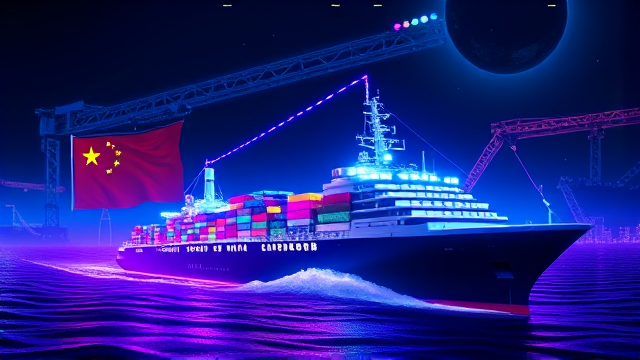China Sanctions US Units of South Korean Shipping Firm
In a calculated geopolitical countermove that signals a significant escalation in the ongoing trade and technology cold war, Beijing has formally imposed sanctions against five U. S.-based subsidiaries of the South Korean industrial behemoth Hanwha Ocean. The Chinese Ministry of Commerce, in a terse statement released Tuesday, explicitly accused the firm of acting as a direct accomplice to Washington’s strategic campaign to constrict China’s maritime ascendancy.This retaliatory strike is not an isolated skirmish but a deliberate maneuver in a much broader, high-stakes conflict over global industrial dominance. The sanctioned entities, integral to Hanwha's global logistics and technology support network, now face severe operational restrictions and asset freezes within Chinese jurisdiction, a move designed to inflict tangible financial pain and send a chilling message to other multinational corporations contemplating alignment with U.S. policy.Concurrently, and with strategic synchronicity, China’s Ministry of Transport has launched a sweeping investigation into the impacts of the U. S.Section 301 probe on its domestic shipping, shipbuilding, and the intricate supply chains that feed them. This parallel action functions as both a shield and a sword—a defensive measure to quantify potential vulnerabilities and an offensive tool to gather ammunition for potential disputes at the World Trade Organization.The Section 301 investigation, a relic of Cold War-era trade law that the U. S.has increasingly wielded as a unilateral cudgel, represents Washington’s attempt to legally justify tariffs or other barriers against what it deems China’s unfair, state-subsidized dominance in commercial shipbuilding. This is a direct assault on a cornerstone of China’s ‘Made in 2025’ industrial policy, an area where it has poured billions in state-backed subsidies to capture over 40% of the global shipbuilding market, effectively dwarfing competitors in South Korea and Japan.The targeting of a South Korean firm’s American units is particularly telling; it’s a classic case of coercive linkage, punishing Seoul for its deepening security integration with Washington through entities like the AUKUS partnership and the recent Camp David trilateral accords. For risk analysts, this creates a precarious scenario for any corporation with a multinational footprint, caught in the crossfire between a revisionist power and an entrenched hegemon.The immediate consequence will be a forced decoupling of Hanwha’s U. S.operations from the lucrative Chinese market, disrupting global supply chains for key maritime components and likely increasing costs for allied navies and commercial fleets that rely on Hanwha’s technology. In the medium term, we can anticipate a tit-for-tat escalation, with the U.S. potentially responding with stricter export controls on maritime technologies, further balkanizing global trade into competing spheres of influence.The long-term strategic risk is the solidification of a bifurcated global system: one maritime supply chain aligned with U. S.standards and security concerns, and another, dominated by China, serving its Belt and Road Initiative and strategic partners. This move by Beijing is less about Hanwha itself and more about demonstrating to allies in Europe and Asia the prohibitive cost of siding with American techno-nationalism.The investigation into the Section 301 impact will almost certainly produce a report detailing significant harm to China’s industry, providing the legal and political pretext for a new wave of countermeasures, potentially including targeted tariffs on American agricultural exports or restrictions on rare earth minerals critical to U. S.defense manufacturing. The shadow of the 2018-2019 trade war looms large, but the current conflict is fundamentally different; it is not merely about trade deficits but about controlling the foundational industries—like shipbuilding, which is inextricably linked to naval power and global logistics control—that will define geopolitical supremacy in the 21st century. For corporate boards and policymakers, the scenario planning must now account for a world where every commercial decision is viewed through a national security lens, and where a company’s operations in one nation can instantly make it a target in another, with profound and lasting consequences for global economic stability.
Latest News
The persistent specter of global hunger, a crisis of both moral failing and systemic collapse, continues to mock the grandiloquent pledges made within the
4 minutes ago0 comments
The sterile, fluorescent-lit corridors of Tel Aviv’s Ichilov Hospital, a place more accustomed to the routine rhythms of illness and recovery, became the stage
14 minutes ago0 comments
In a development that resonates with the careful calibrations of political power observed throughout modern history, Hu Xijin, the former editor-in-chief of
44 minutes ago0 comments
The fatal attack on a Kenyan police officer at the main gate of the president's official residence in Nairobi has sent immediate and chilling shockwaves
2 hours ago1 comments
The political landscape of Madagascar has been plunged into a state of high-risk uncertainty following the sudden and clandestine departure of President Andry
3 hours ago2 comments
The political theater unfolding for Donald Trump presents a study in stark duality, a phenomenon not entirely without precedent in the annals of American
3 hours ago1 comments
The political theater gripping Malaysia's opposition party Bersatu has escalated into a full-blown purge, with the Tuesday sacking of a sitting MP and four
3 hours ago0 comments
In a significant pivot of diplomatic focus, President Trump has declared his intention to shift the weight of American statecraft from the protracted Gaza
3 hours ago2 comments
It’s quiet here...Start the conversation by leaving the first comment.
